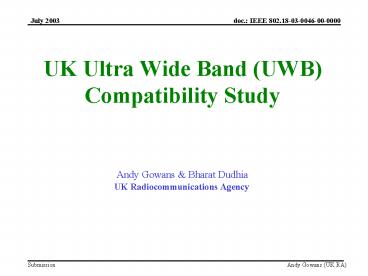UK Ultra Wide Band (UWB) Compatibility Study - PowerPoint PPT Presentation
Title:
UK Ultra Wide Band (UWB) Compatibility Study
Description:
Digital Terrestrial TV. COFDM (multi carrier modulation) - 2k & 8k ... Terrestrial Digital Audio Broadcasting. Design for fixed, portable and mobile reception ... – PowerPoint PPT presentation
Number of Views:98
Avg rating:3.0/5.0
Title: UK Ultra Wide Band (UWB) Compatibility Study
1
UK Ultra Wide Band (UWB)
Compatibility Study
Andy Gowans Bharat Dudhia UK
Radiocommunications Agency
2
UWB Compatibility Study CEPT PT SE24
- CEPT PT SE24 UWB Study
- To investigate the interference potential of
various Pulsed UWB technology on existing and
planned services - Laboratory measurements and theoretical
calculations. - UWB Interference and victim receiver bandwidth
- Noise - like (Receiver BW lt UWB PRF)
- Pulse - like (Receiver BW gt UWB PRF)
- UWB Signal characteristics for Interference
tests - PRF (1/5/10 MHz)
- Modulation type gt PPM
3
UWB Compatibility Study CEPT PT SE24
- Victim Services
- Broadcast services (T-DAB / DVB-T)
- Radio Astronomy (Passive services)
- Earth Exploration Satellites (Active Passive)
- GPS
- UMTS
- Galileo
- PCN
- Aeronautical services
- COFDM ENG/OB
- SRDs
- 5GHz HIPERLAN
4
Compatibility Study
- RA Contribution to CEPT
- To assess the UWB interference into
- (1) DVB-T
- (2) TDAB (MODE 1 2)
- (3) PCN (GSM)
- (4) Bluetooth
- (5) 5GHz RLAN
- Objectives
- (1) C/I Ratios (based on UWB power falling into
victim receiver's IF BW) - (2) Minimum separation distances
- (3) Maximum permissible E.I.R.P. for UWB
- (4) Compare results with use of proposed CEPT and
EMC/FCC limits.
5
FCC UWB emissions limits for indoor communication
and measurement systems. Units with center
frequencies greater than 3.1 GHz
6
FCC UWB emissions limits for outdoor
communication and measurement handheld systems.
Units with center frequencies greater than 3.1 GHz
7
Proposed CEPT emissions limits for indoor and
outdoor UWB communication and measurement
systems.
8
UWB Interference into DVB-T (1)
- Digital Terrestrial TV
- COFDM (multi carrier modulation) - 2k 8k FFT
- QPSK - 16QAM - 64QAM
- 2/3 FEC
- 1/32 Guard interval
- 7.61 MHz BW
- UK Mode (2k FFT, 64 QAM, 2/3 FEC, 1/32 Guard
Interval) - Conducted Measurements
- Objective measurements (BER tests)
- Failure criteria - BER of 2x10-4 (before RS
decoder)
9
UWB Interference into DVB-T (2)
- C/I Results
- 6.5 dB (QPSK)
- 11.6 dB (16 QAM)
- 19.4 dB (64 QAM)
- Protection Distances (SE24 Calculations)
- UWB emission level
MUS MUS10dB - EMC/FCC Part 15 limit (-41dBm/MHz) 33.31m 10.5
3 - Proposed CEPT Mask 0.01m 0m
10
UWB Interference into DAB (1)
- Terrestrial Digital Audio Broadcasting
- Design for fixed, portable and mobile reception
- ETSI Standard (EN 300 401)
- COFDM - DQPSK
- 1.5 MHz BW
- 5/6 Near CD quality Programs per Block
- Receiver Sensitivity -81dBm - (CENELEC
standard) - -90dBm
(typical receiver performance) - Frequency allocations VHF (band 3) (217-230
MHz) -
L band (1.5GHz) - Failure criteria - subjective listening test
11
UWB Interference into DAB (2)
- C/I Results
- 9.6 - 12.5 dB
- Protection Distances (SE24 Calculations)
- UWB emission level
MUS MUS10dB - EMC/FCC Part 15 limit (-41dBm/MHz) 22 m
7 m - Proposed CEPT Mask
lt1m lt1m
12
UWB Interference into Bluetooth (1)
- A global standard for wireless connectivity
- connecting mobile phones, computers,
laptops, - Low Power - Low Cost radio links (Voice and Data
) - Technology
- 2400 - 2483.5 MHz ISM Band gt ETS 300 328
- Fast Frequency Hopping system
- over 79 channels - 1MHz spacing
- 625µs timeslot
- pseudo random hopping sequences
- frequency separation at least 6MHz
- Time division duplex (TDD)
- Failure Criteria - Voice (subjective listening),
BER, file transfer time
13
UWB Interference into Bluetooth (2)
- C/I Results
- 17 dB (Voice)
- 19 dB (data-file transfer test)
- 20 dB (BER Tests)
- Protection Distances (SE24 Calculations)
- UWB emission level
MUS MUS10dB - EMC/FCC Part 15 limit (-41dBm/MHz) 2.6 m
0.8 m - Proposed CEPT Mask
lt1m lt1m
14
UWB Interference into PCN/GSM (1)
- 2nd Generation Pan European Cellular
System - GSM (800MHz) / PCN (1800 MHz)
- GFSK, 270kb/s,
- TDMA (8 user per channel)
- Receiver Sensitivity (-102 dBm)
- Conducted Measurements
- GSM test set
- C/I Measurements
- Failure Criteria (mobile station receive quality
4 with traffic channel BER 2)
15
UWB Interference into GSM (2)
- C/I Results
- 9 dB
- Protection Distances (SE24 Calculations)
- UWB emission level
MUS MUS10dB - EMC/FCC Part 15 limit (-41dBm/MHz) 41 m
13 m - Proposed CEPT Mask
lt1m lt1m
16
UWB Interference into PCN (3)
- C/I Results
- 9 dB
- Protection Distances (SE24 Calculations)
- UWB emission level
MUS MUS10dB - EMC/FCC Part 15 limit (-41dBm/MHz) 21 m
6.6 m - Proposed CEPT Mask
lt1m lt1m
17
UWB Interference 5GHZ RLAN
- C/I Results (dB)
- 6Mbps 9Mbps 12Mbps 18Mbps 24Mbps
36Mbps 54Mbps - BPSK 1/2 BPSK 3/4 QPSK 1/2 QPSK 3/4 16QAM
1/2 16QAM 3/4 64QAM 3/4 - 6 9 9
10 13 24
26 - Protection Distances (SE24 Calculations)
- UWB emission level
MUS MUS10dB - EMC/FCC Part 15 limit (-41dBm/MHz) 5.67m 1.79
m - Proposed CEPT Mask 5.67m 1.79m
- Failure criteria - 10 Frame Error Rate
18
Summary
- CEPT compatibility study in progress
- Pulsed UWB-PPM gtgt Noise like interference
- UWB emission level
- EMC/Part 15 limit (-41dBm/MHz) gtgtSharing under
worst case scenario may not be possible
(DVB-T/PCN/TDAB/Bluetooth) - Proposed CEPT (SE24) mask gtgt Separation distance
lt1m apart from 5GHz RLANs. - Effect of different UWB-PRF (1/5/10 MHz) gtgt 2-3
dB - Further Measurements
- UWB/3G
- ITU-R Task Group 1/8
19
CEPT compatibility study in progress PT SE24
-provisional results this includes aggregate
interference analysis for a no.of devices

